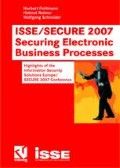Abstract
High Density cards represent the next generation of secure portable and removable tokens for the mobile and wireless markets. What makes these cards so particular is that, in addition to the traditional ISO 7816 interface to the Subscriber Identity Module, there are hundreds of megabytes of non-volatile Flash Memory available on the same token. This is a small revolution when compared to current EEPROM cards which allow for only a few hundreds of kilobytes of memory both for applications and data. Flash memory can be accessed either via a USB (Universal Serial Bus) or an MMC (MultiMediaCard) high speed interface. Therefore two different ecosystems co-exist on the same chip, which makes the security aspects of these cards particularly interesting and challenging.
In this paper we examine the specific security aspects of such high density cards and explain what potential security issues a manufacturer has to face and how he can overcome them. We discuss specifically how flash memory interacts with other memory on board, how it is organised, what it is used for. We contrast this approach with the memory architecture and organization of conventional smart cards such as those used in GSM and EMV payment applications. Since there is no ROM memory at all on these cards, we explain where the proprietary and highly sensitive operating system of the card manufacturer and the proprietary algorithms of the telecommunications operators will reside, how they can be protected and what the challenges are for initializing the whole system. Current secure smart card personalization techniques will have to be revisited and new procedures need to be put in place to securely instantiate this new generation of (SIM) cards. New algorithms for EEPROM emulation and anti-tearing (the fact that data is not lost when power is lost abruptly) need to be developped, one-time programmable areas need to be provided to boot-up securely. Initial program loader techniques and public key schemes are required for secure personalization. The high speed interface has to be secured and separated from access to the main memory on chip.
We also discuss security aspects of single die architectures, platform security for flash memory cards and security aspects of cryptographic hardware cores including the necessity to protect them against side-channel attacks as on traditional smart cards. These security features in turn allow considering high density cards for enhanced security applications such as secure data storage thanks to on-the-fly encryption at the megabyte rate, enterprise DRM, DRM agents for mobile TV, mobile payment and m-commerce. New applications which require huge storage capacity and sophisticated security features at the same time are enabled with this new generation of smart removable devices.
Access this chapter
Tax calculation will be finalised at checkout
Purchases are for personal use only
Preview
Unable to display preview. Download preview PDF.
References
Constantinou, A.: High Capacity SIMs: A White Paper. Informa Telecoms and Media. 2006. http:// visionmobile.com/whitepapers.html
International Standards Organization, ISO 7816 Identification Cards — Integrated circuit(s) cards with contacts. Parts 1 to 4.
Hassinen, Marko, Hypponen, Konstantin, Trichina, Elena: Utilizing National Public-key Infrastructure in Mobile Payment Systems. In: Electron. Comm. Res. Appl., Elsevier, 2007, doi: 10.1016/j. elerap.2007.03.006. Available online at www.sciencedirect.com
http://www.openmobilealliance.org
Author information
Authors and Affiliations
Rights and permissions
Copyright information
© 2007 Friedr. Vieweg & Sohn Verlag | GWV Fachverlage GmbH, Wiesbaden
About this chapter
Cite this chapter
Handschuh, H., Trichina, E. (2007). High Density Smart Cards: New Security Challenges and Applications. In: ISSE/SECURE 2007 Securing Electronic Business Processes. Vieweg. https://doi.org/10.1007/978-3-8348-9418-2_26
Download citation
DOI: https://doi.org/10.1007/978-3-8348-9418-2_26
Publisher Name: Vieweg
Print ISBN: 978-3-8348-0346-7
Online ISBN: 978-3-8348-9418-2
eBook Packages: Computer ScienceComputer Science (R0)

